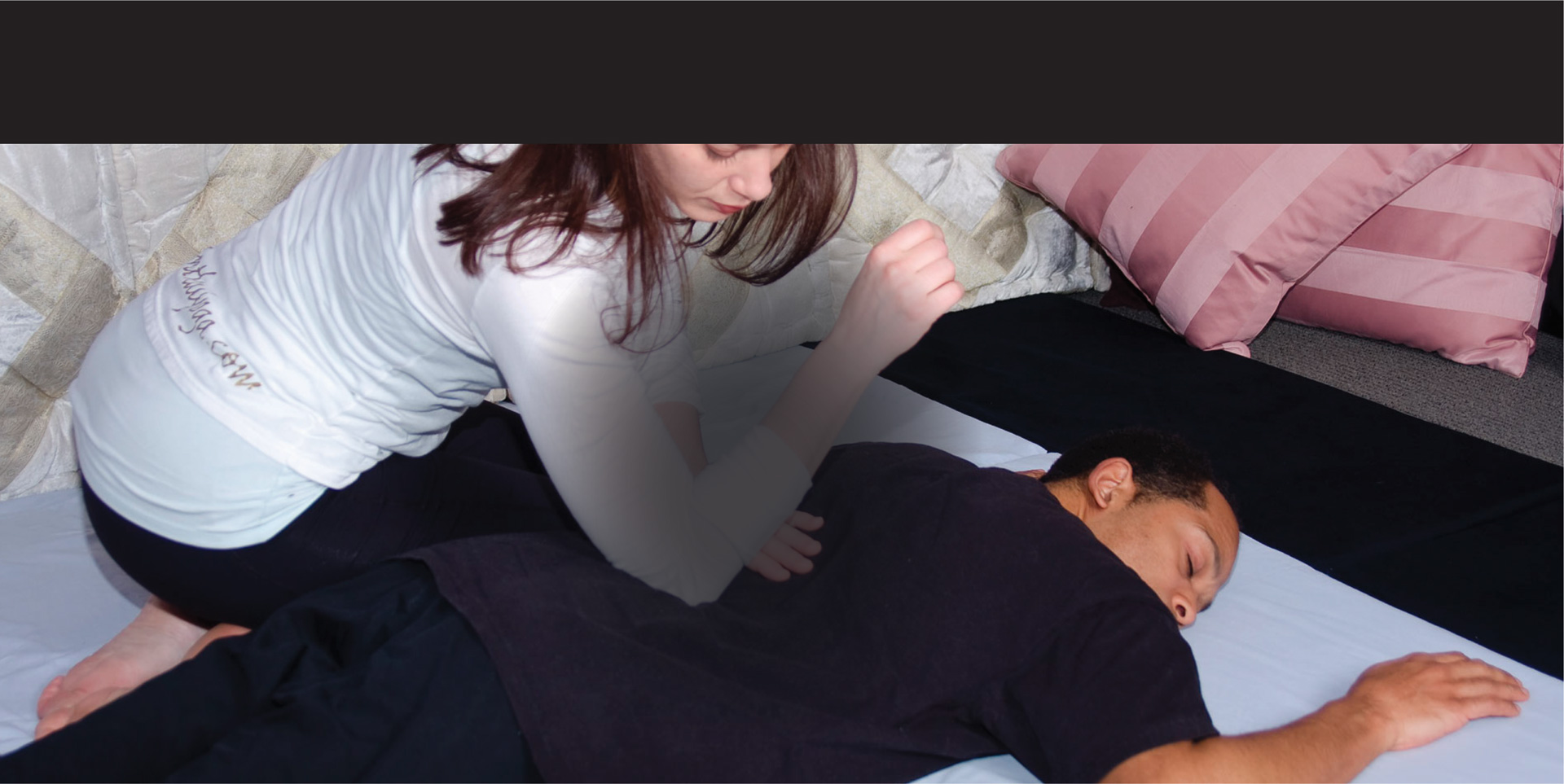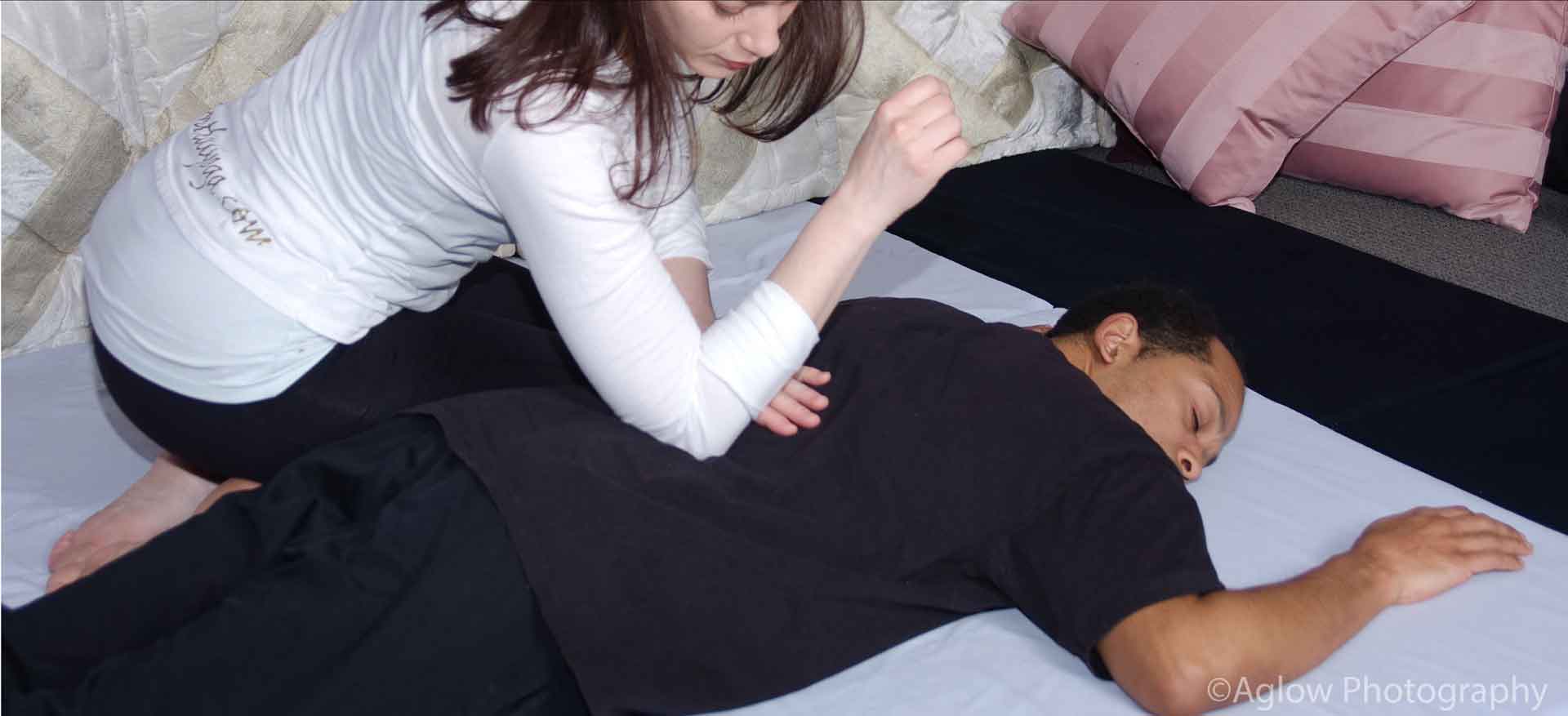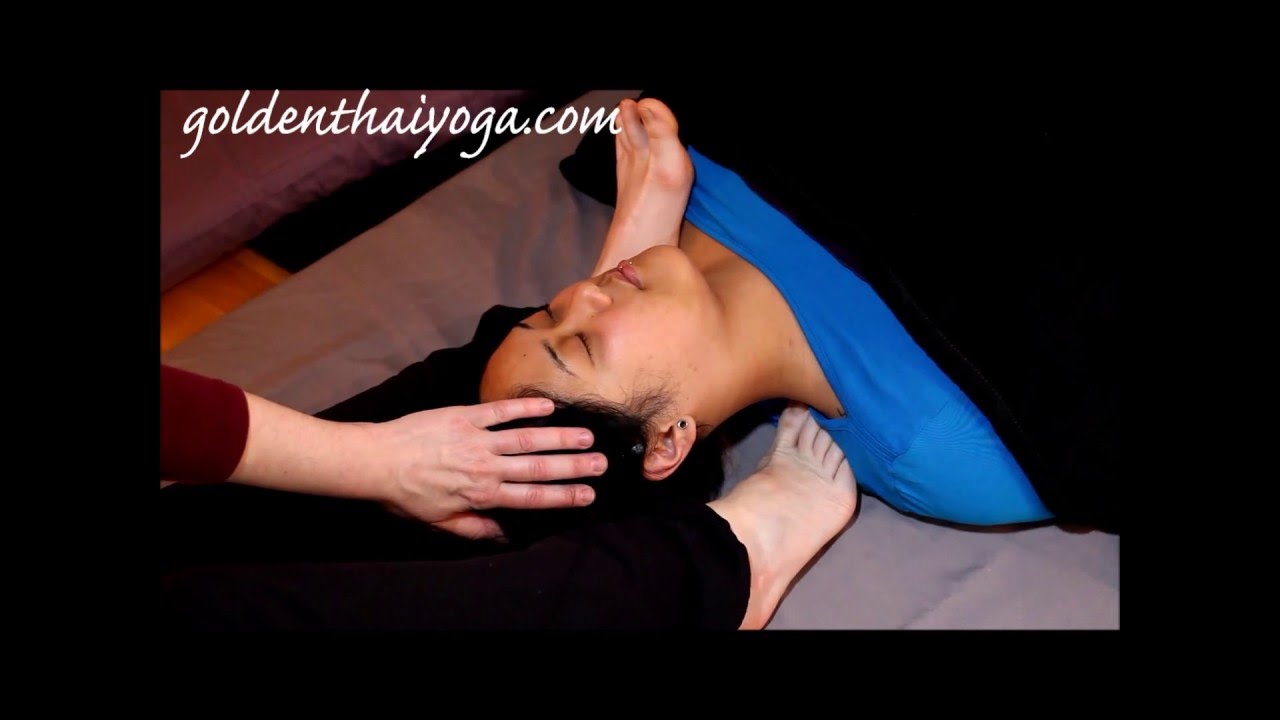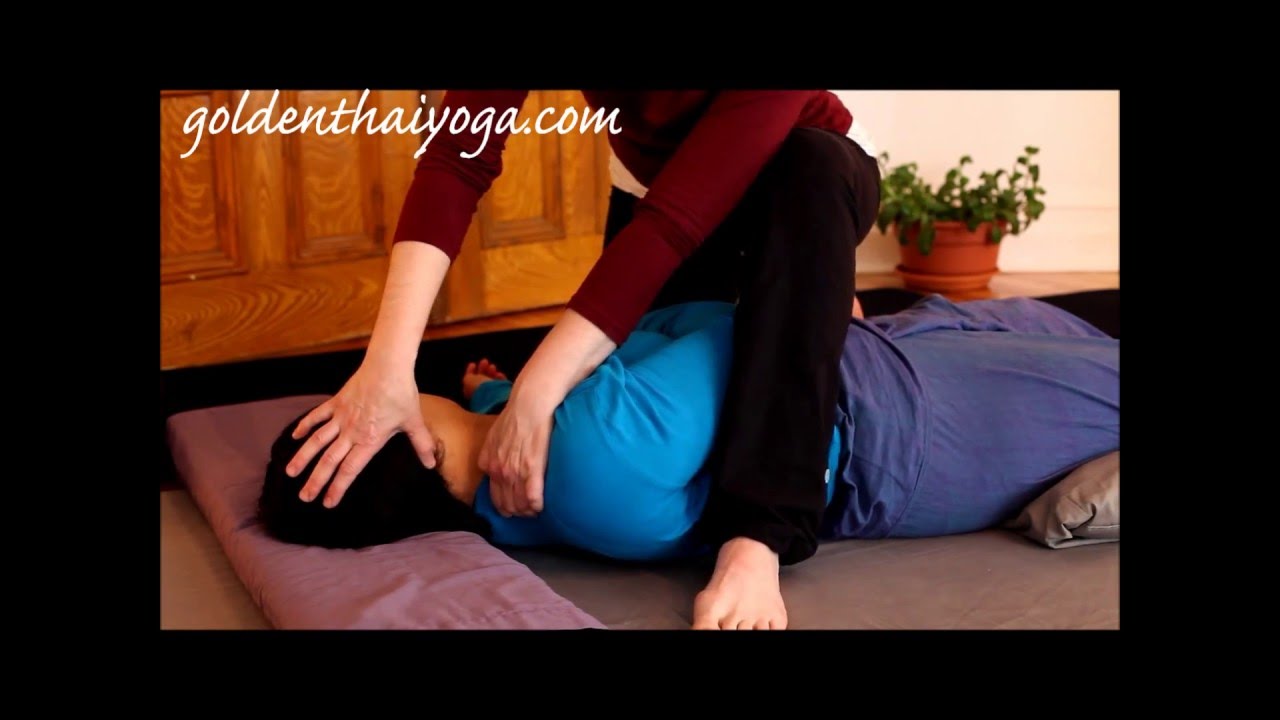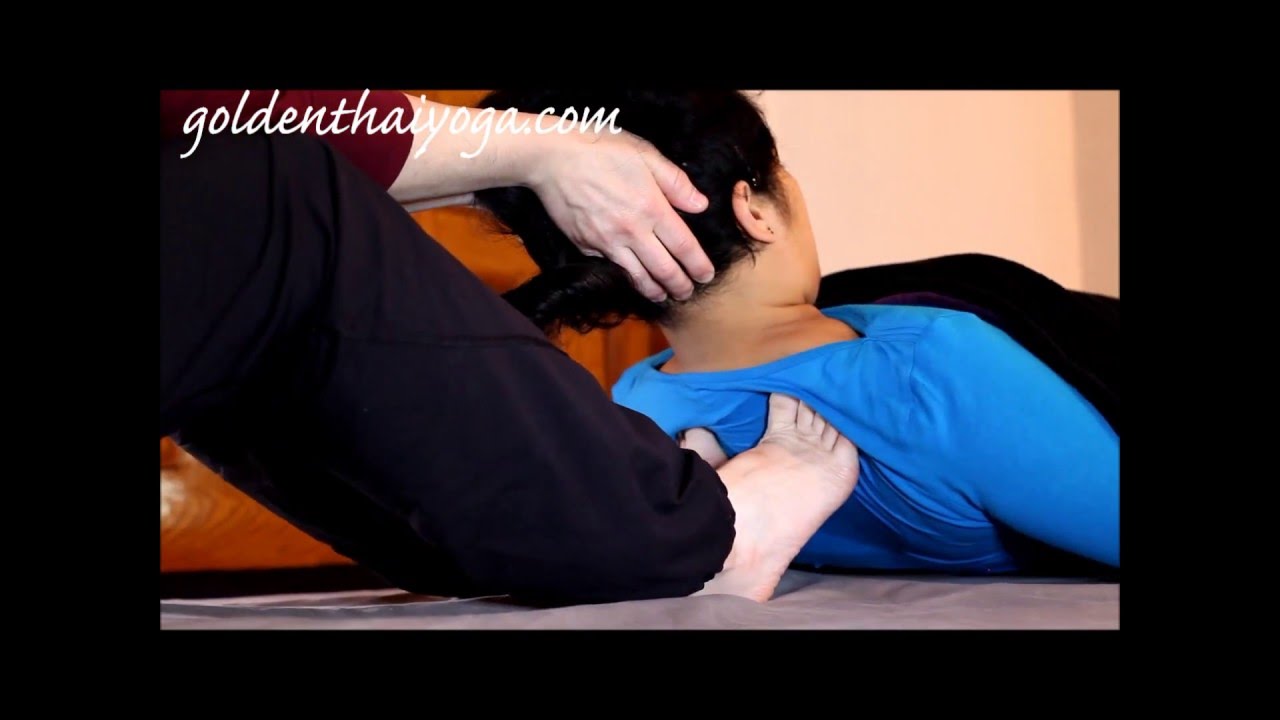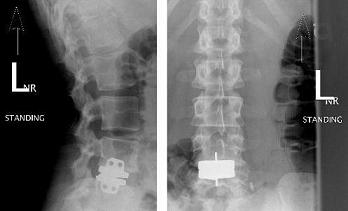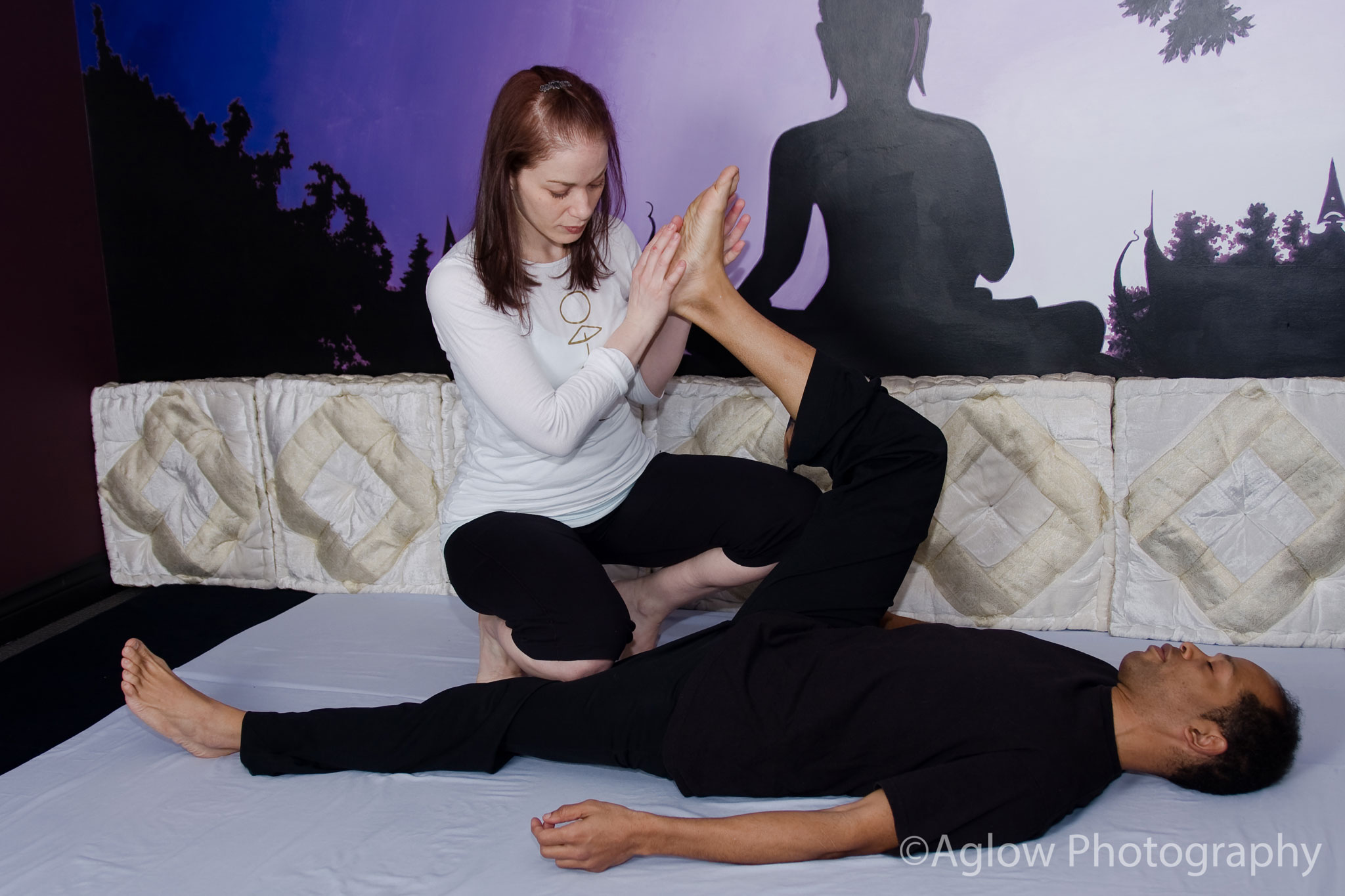
WHY THAI MASSAGE
Traditional Thai massage dates back nearly 2500 years to the time of the Buddha. It’s a profound and effective method that relieves muscle tension and joint pain, like the neck and shoulders, back pain, knee or ankle pain, and even the elbows and wrists! It also treats the symptoms of insomnia, anxiety, headaches and migraines, digestive issues, fatigue, and more!
A Thai massage takes place on a floor mat, similar to a futon. You are comfortably dressed, and *this* therapist applies acupressions along the energy lines (named “Sen” lines) using (mostly) her elbows, knees and feet, but also with palms and thumbs. Passive stretching helps elongate muscle tissues to help improve your range of motion and flexibility, and leaves you with a sense of lightness and well-being!
A Thai massage session can be therapeutic, or it can be both relaxing and/or energising! It is tailored to fit each individual, and it is, quite simply, the greatest massage form on this planet.
I look forward to helping to rid you of your pains 
Namaste,
Stephanie

WHY THAI MASSAGE
Traditional Thai massage dates back nearly 2500 years to the time of the Buddha. It’s a profound and effective method that relieves muscle tension and joint pain, like the neck and shoulders, back pain, knee or ankle pain, and even the elbows and wrists! It also treats the symptoms of insomnia, anxiety, headaches and migraines, digestive issues, fatigue, and more!
Read More
A Thai massage takes place on a floor mat, similar to a futon. You are comfortably dressed, and *this* therapist applies acupressions along the energy lines (named “Sen” lines) using (mostly) her elbows, knees and feet, but also with palms and thumbs. Passive stretching helps elongate muscle tissues to help improve your range of motion and flexibility, and leaves you with a sense of lightness and well-being!
A Thai massage session can be therapeutic, or it can be both relaxing and/or energising! It is tailored to fit each individual, and it is, quite simply, the greatest massage form on this planet.
I look forward to helping to rid you of your pains 
Namaste,
Stephanie
what the people say
Testimonials
Traditional Thai Massage
Rates
Thai Massage Videos
Frequently Asked Questions
Please don’t hesitate to call or write
I have a cold (or, I'm just getting over one), can I receive a massage?
The flu is going around. If you are sick, please keep your germs at home. If you come in for a massage with a cold, I will send you home. Because the alternative is to risk catching it myself and giving it to possibly three days’ worth of clients (and thus, their families) before I even know I’ve caught it. Not to mention then missing a week or more of work, myself. I’m sorry but it’s just not worth the risk. Thank you for your understanding and consideration.
WHICH COMMON PAINS CAN THAI MASSAGE HELP WITH?
Thai massage is great for relieving:
– shin splints (tennis players, joggers)
– improving range of motion (golfers)
– elbow pain (frequently in professions requiring manual dexterity, such as mechanics and large machine operators)
– neck and shoulder tension (desk jobs, journalists, computer work)
– back and leg tiredness (standing jobs, like waiting tables or table-massage therapists!)
– back pain, sciatica or piriformis syndrome (“false sciatica”)
– leg pain due to knee problems (and vice-versa)
– leg and foot cramps
– insomnia, anxiety, lack of concentration
– digestive issues
– headaches brought on by tension or stress
HOW DOES THAI MASSAGE WORK?
Thai massage consists of
(1) passive mobilization & stretching
(2) compressions along energy lines (called “Sen”)
(3) rhythmic rocking motion
(4) guided breathing, meditation, compassion
1. Passive stretching affects the muscle tissues and nervous system quite differently from active stretches. During active stretching, the brain essentially sends signals to the muscles limiting the extent of the movement to prevent injury. It says “This is how far it is safe for me to go”.
In order to actively stretch a muscle, its opposite (antagonist) must contract. It logically follows that you can’t stretch a muscle further than you are able to contract its antagonist: consider your triceps and biceps. You can’t stretch the one any further than you are able to contract the other – at least not without the help of the other hand! During a Thai massage, muscles are stretched without the active contraction of their antagonists.
And then there is “muscle memory”: muscles that have been in a tense position or doing a repetitive motion over a long period of time, quite literally “forget” what it means to be extended and relaxed. Indeed, the muscles (and the person) believe they are relaxed, but in fact are not. A good example of this is how, in the winter, we tend raise our shoulders to keep our neck warm…
The passive mobilization and stretches in Thai massage “remind” the body (& the brain) that it can indeed move in a given direction – that your shoulders don’t belong up by your ears! – and achieve a greater range of motion, as muscle fibres are extended without the conscious, active contraction of the antagonist (opposite) muscle (i.e. quads/hamstrings).
2. The Sen are energy lines that go all over, through and around our body; there are some 72,000 lines practically forming another body in, on and around each of us. In Thai massage, 10 of these lines are considered most important – don’t ask me how these 10 were chosen, they just are. (“Wax on, wax off.”)
Compressions are applied along the sen, helping to release energy blockages along the way and promote the free flow of energy.
In physiological terms then, for the skeptics who resist “energy talk”: Incidentally, these lines follow along muscle tissues and nerve and blood pathways (how about that?). The practitioner uses thumbs, palms, elbows, knees and/or feet to squash the fibers all along muscles, from origin to insertion. This causes micro-tears in the muscle tissues and then the body’s fluids rush in to do their repair work. Kind of the same principle behind how exercising and lifting weights builds muscle.
3. The practitioner is almost always in a rocking motion: side to side, forward and back, and in circles (whirlpool). It allows the practitioner to transfer their body weight to achieve pressure, rather than using force (which would be very tiring). This constant rocking, which also transfers to the recipient, calms both their nervous systems. It’s one of the reasons practitioners themselves usually “feel better after” having given a Thai massage.
4. My Thai massage master has explained meditation as such: “Meditation is not the absence of thought, but rather the space in between thoughts”.
I like to compare meditating to competitive swimmers. Our brain is made to think, that’s what it does; how can you train it not to? Similarly, our lungs are made for breathing, you can’t ask them not to. We don’t rapidly breathe “in-out-in-out-in-out” — we’d get all light-headed and pass out! There is a …pause… between breathing out… and the next breath in… and then out again… Athlete swimmers don’t hold their breath; with practice, they train their lungs to need breaths less often, to lengthen that pause in between the inhale and exhale. The way swimming trains the lungs, meditation is training for the brain. With practice, we can learn to expand that space in between thoughts, and with practice, we can learn to find that quiet space more and more easily when we need it. Having that quiet space quiets the “noise” in our brains, and allows us to better focus our energy.
Thai massage is a meditative practice, in that both giver and receiver are completely present and mindful of their breathing for the duration of the session. This state of mind allows the practitioner to be more aware of, and in tune with the recipient’s responses to each posture. When giving a Thai massage, the practitioner is giving of their kindness, compassion and caring; to help the receiver feel better.
HOW DOES THAI MASSAGE DIFFER FROM “REGULAR” OIL MASSAGES?
Thai massage is better! 
Ok, ok, I’m biased. Do you mean, besides the stretching and the rocking, and that it’s done on a mat instead of a table, and that you’re dressed comfortably instead of in your birthday suit?
Most massage forms that use oil, massage the superficial tissues just below the skin. Even these can be a “strong” massage, but their beneficial effects may dissipate fairly quickly, sometimes within hours. The body also has “deep” muscles, close to the bone, that cannot be palpated (felt by means of touch) because there are layers of superficial muscle on top of them. The only way to relieve the tension or pain in those deep muscles is to compress — in other words, squash down — the superficial muscles down into the deep ones. This is why the effects of a Thai massage can last for a week or more
WHAT DO THEY MEAN BY “ENERGY”?
Good question. Here is how I see it. We take in “prana”, or energy, when we inhale air, and we exhale stale energy, depleted of oxygen.
When we are tired or lethargic, our “energy is low”. When we are excited or nervous, our energy is high. Kids often have too much energy!
Long ago, when tension or pain occurred, “blocked energy” was only one of many ways to define it. When a muscle trembles or spasms as it is relieved and relaxed, energy is released or unblocked.
What we refer to as “energy lines” (or Sen lines) follow bone, muscle tissues, nerves and blood pathways. The recipient “feels energized” for several days following a session, because their body feels good or hurts less.
Bones are composed of minerals. Minerals are crystals. Crystals hold an electrical charge (energy!).
When I work, I follow the Sen. But my hands feel tissues and reactions (while intuition and experience dictate my pace and pressure). I believe that energy was around long before we acknowledged it, let alone learned to manipulate it. I am a firm believer in the teaching method of “do this like this, and it works, you don’t need to know why”, because if you “do this, like this” with the right intentions, the energy will take care of itself.
HOW OFTEN SHOULD I RECEIVE THAI MASSAGE?
If you live in Thailand, or you are rich, or have a really great health insurance plan: every day. Barring these, I say live in the moment and see how you feel.
You can expect the effects of a Thai massage to last about a week. It’s more important to develop an awareness for how your body is feeling, and not to let the tension and pain build up before going for your next session. Maintenance is more effective than chasing crises.
CAN THAI MASSAGE RELIEVE PAIN IN THE JOINTS?
The short answer is yes. Scroll down to the next question or read on for long answer.
I see the body as a system of sticks and elastics. If you have too much tension in one elastic, it stands to reason that all the other elastics down the line of sticks will also feel the effect of that pull.
Our muscles — our elastics — cross our joints (you’d be surprised how many people don’t realize this simple fact). When our muscles are too tight, they exert pull on the bones toward each other at the joints, the weakest points in our system of elastics and sticks. And then we start walking funny, and things start to hurt.
But which comes first, the joint pain or the muscle tension? It doesn’t matter, the result is the same. Because muscles that cross a painful joint, will contract in response to that pain, causing further pain.
If you can relieve the tension in the muscles that cross a given joint, you can relieve the pain in the joint without ever touching the joint itself. Thai massage does this.
IS THAI MASSAGE GOOD FOR BACK PAIN?
The back is a huge system of joints, with no shortage of muscles crossing them. Yes, there is nothing like Thai massage for back pain (or knee pain, or ankle, elbow, shoulder or neck pain). A client who came to see me recently, with chronic back pain, said afterwards that she felt like a new person. Personally, I need a Thai massage at least once a week; I can only wish I had discovered Thai massage waaay back when I was waiting for spine surgery!
I’VE NEVER DONE YOGA BEFORE (OR “I’M NOT FLEXIBLE”); DO I NEED ANY EXPERIENCE TO TRY THAI MASSAGE?
How many years’ of breathing experience do you have? Do you know how to do nothing? Great, that’s all you need!
You do not need any yoga experience; you do not have to be all bendy and flexible. Thai massage is adapted to the individual, and there are thousands of possible postures to put you in. A skilled therapist knows that the art of Thai massage is knowing what *not* to do.
IS THAI MASSAGE GOOD FOR WEIGHTLIFTERS?
Yes. Often, body builders lose some measure of flexibility and mobility as their muscle mass increases – for example, they can no longer apply lotion to their entire back by themselves, or can’t touch their toes. Weight lifting increases the width, the breadth of the muscle fibres.
Thai massage, like yoga, lengthens muscle fibres and helps the body regain its flexibility, and restores the joints’ mobility and range of motion. Thai massage is a safe introduction to yoga and stretching in general, and it’s far more pleasant than physiotherapy ?
About the therapist
Stephanie Golden
I am a member of the following associations and upon request, can provide receipts for your insurance.
– AQTN – Alliance québecoise des Thérapeutes naturels
Trained by Lotus Palm, I am a Thai yoga massage therapist and teacher. It is the only method I practice, because I’m head-over-heels in love with Thai massage! To book a session, please click the button on the right.
My environment has always been athletically oriented. I’ve been an American Red Cross certified swim instructor (WSI), and also an AFAA certified aerobics instructor. I also used to figure skate, since about the time I could walk until about my mid-twenties, from childhood competitions to Rockefeller Center’s Fashions on Ice.
I bear the honourable distinction of being Canada’s first certified teacher of Yogic Arts, a fusion form combining yoga, martial arts and Thai massage in order to deepen asanas.
At 32 years of age, a degenerative spinal condition began limiting my mobility and affecting my daily life – or more accurately, affecting my mobility and limiting my daily life. It became especially hard to cope as I went from being an athlete to hardly being able to walk a few blocks without having to stop and rest; groceries and laundry became a frustrating and painful challenge.
Read More
Although a combination of yoga and swimming helped to manage the pain, along with conservative treatments including spinal injections over the course of five years, my condition worsened to the point where an artificial disc replacement became necessary in 2006.
Relatively speaking, recovery was instantaneous; within days my back felt better than it ever had. By three months following surgery, I was back to roller-blading and step classes, and my interest in yoga perhaps waned slightly as I relished all the sports I’d once been forced to give up.
Between the disc degeneration and a contracted posture that developed in reaction to low back pain, I had lost about an inch in height. Since my surgery I have regained that inch, and then some. While physiotherapy helped me regain some of my former flexibility, it’s at that moment in my life that Thai massage decided to make itself known to me.
My first Thai massage experience was to receive it: to be manipulated, sat upright, supported, laid back, folded over, stretched this way and that, and massaged at the same time (what?) while I was put in these yoga postures – my first reaction was the very same as many of my now clients’ first reactions: “Wow! I’ve never felt anything like that in my life!” (Smacking my head, all “I coulda had a V8!”-like. If you have back pain, get you a Thai massage right now!)
And that was it for me: This was the life I had long been looking for. I’ve had the honour of studying with Kam Thye Chow, the founder of Lotus Palm School, and co-authoring a publication entitled The Art of Using Props within the Lotus Palm Thai Massage Form that is included in Lotus Palm’s Level 1 teaching module. Each of my teachers – Mia Blackwell, Shai Plonski, Blake Martin, Jyothi Watanabe and Sukha Wong, has brought something special to my practice, from techniques, to perspectives, to the littlest nuances that create an exceptional massage experience.
One of the best parts of Thai massage, for me, is that it is as good for me, as a practitioner, as it is for my clients. As I bring a recipient into each yoga posture, I am myself assuming stable stances based on yoga and martial arts principles. As such, the “physical application of loving kindness” is a two-way line. It is an exchange of positive energy, and as I care for myself, I am able to care for others.
I am blessed to practice and teach Thai massage, to pass on this skill that has enhanced and changed my life, and I feel privileged to be able to bestow that feeling of “Wow” upon someone, to “do yoga to someone” and share its benefits.
With metta
Stephanie Golden
Get In Touch
By Appointment Only
Monday – Sunday: 10 AM – 8 PM
Receipts Provided
Upon request for your private health insurance reimbursement!
MONTREAL
3891 Saint Denis, top floor
Qc H2W 2M2
AS OF JAN 2024!
GRIFFINTOWN
Private studio, please call

